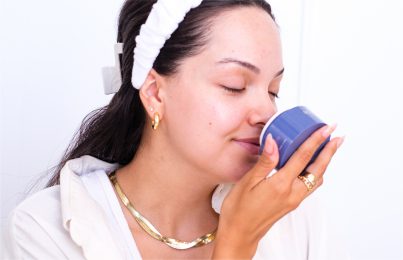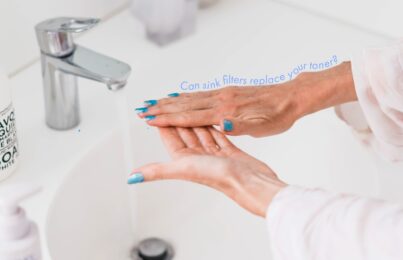If you’re one of the many people predisposed to dry skin, you know what an annoyance it can be. But if you’re one of nearly 17 million adults in the U.S. living with eczema, it’s more than just an annoyance. Eczema (also known as atopic dermatitis) can range from uncomfortable to downright painful, and a stubborn flare-up can be harder to get rid of than a wine stain on your favorite white tee.
One of the most irritating (no pun intended) things about eczema is that you have to be much more cautious than most people about what you put on your skin. Trying new products can go from a fun experiment to an “uh oh” moment in the blink of an eye. Putting together the right routine for your skin is a daunting task under the best of circumstances, but when you’re navigating the minefield that is eczema, it can feel impossible.
With this post, I’m setting out to make that task a little easier. I’ve tapped into board-certified dermatologist Dr. Marisa Garshick for deeper insights into what eczema is and how to manage it. I’ll also share my top recommendations for an eczema-friendly skincare routine. Let’s get started!
What Does Eczema Look Like?
According to Dr. Garshick, eczema can manifest as pink, red, or brown scaly patches. A general roughness of the skin is also common. For many people, eczema causes itchiness. Dermatologists call it “the itch that rashes,” because eczema rashes are thought to result from scratching already inflamed skin.
Eczema can appear on the face or the body. On the body, it commonly affects flexural areas (areas that bend). This means the crease of the arm, behind the knees, or the hands—especially knuckles and wrists. Eczema on the face commonly shows up on the eyelids or around the mouth. I know this all too well; I had eczema as a child, and as an adult, my flare-ups have always been on my eyelids.
In some cases, eczema can be easy to spot. In others, it can be a lot sneakier. If you suspect you have eczema, it’s best to get an official diagnosis from a dermatologist before moving forward. Depending on the severity, your dermatologist may prescribe a topical steroid or non-steroid cream to use during flare-ups.
What Causes Eczema?
It’s unclear exactly why some people are prone to eczema, though many experts suspect it’s related to a gene mutation that makes it harder to create one of the proteins required to maintain a strong skin moisture barrier. In fact, research has directly linked eczema to abnormalities in the skin’s moisture barrier.
But what does this mean, exactly? The moisture barrier is the outermost layer of skin. It’s made up of lipids (oils), and its purpose is to protect the skin by keeping water in and irritants out. Anyone can experience a temporarily damaged moisture barrier, for a number of reasons. The thing is, most of us can correct that damage fairly quickly. For those who have eczema, barrier damage is a chronic concern. This ultimately means you’re genetically more susceptible to inflamed, dry, and irritated skin.
How to Manage Eczema Through Lifestyle Changes
Avoid Triggers
The first step to suppressing eczema flare-ups is removing as many triggers as possible. The list of possible triggers is long, and you won’t be able to control all of them, but it helps to understand what might set off a flare-up:
- Cold, dry weather
- Intense heat or humidity
- Allergens, such as dust mites, pollen, or mold
- Harsh soaps and detergents
- Rough clothing like wool (this even turned out to be the cause of my client’s mysterious chin and neck rash)
Take Lukewarm Showers
“For those who suffer from eczema,” says Dr. Garshick, “it’s recommended they take short, lukewarm showers or baths only once daily.” She also advises moisturizing immediately after, no matter what, to prevent water loss. This means doing your skincare routine right after getting out of the shower.
Wear Breathable Fabrics
Whenever possible, Dr. Garshick also advises wearing breathable fabrics that won’t create too much friction as this can aggravate eczema and increase itchiness.
Use a Humidifier
Hydrating your environment can be an effective way to hydrate your skin. Read about the six benefits of using a humidifier in your bedroom.
How to Create an At-Home Skincare Routine if You Have Eczema
Because eczema is characterized by chronic inflammation, the goal first and foremost should be to support your moisture barrier and keep the skin calm.
The Basics—What to Use and Which Ingredients to Avoid
The cornerstone of any skincare routine for eczema is a gentle cleanser and moisturizer. When you’re experiencing a flare-up, this is pretty much all you’ll want to use (aside from sunscreen, which we’ll tackle in just a second).
Cleanser
First up, your cleanser. Dr. Garshick says it’s best to stick with cleansers that won’t strip the skin of its natural oils. This means using a cleanser that’s free of these sulfates. She notes it’s best to look for a hydrating gel or cream cleanser. One of my favorites to recommend to clients with eczema is Vitamin-Infused Cleansing Emulsion.
Moisturizer
Consistently using moisturizer is critical. Since eczema impedes the skin’s ability to hold on to moisture, you’ll want to opt for thicker moisturizing creams or lotions that help trap water. Look for ingredients that strengthen and support the skin barrier, such as ceramides and plant oils. My absolute favorite moisturizer to use when my eczema flares up is the Phytolipid Comfort Creme. It’s so rich and comforting, plus it contains a medley of barrier-friendly ingredients. When I personally have flare-ups, I like to slather a thick layer of cream onto the affected area. After a few minutes, I tissue off the excess so it doesn’t seep into my eyes.
When experiencing flare-ups, you can even use a petrolatum ointment like Vaseline on affected areas. This is the same concept behind slugging, which is a safe way to temporarily keep damaged skin protected from water loss and irritation.
When your skin isn’t as aggravated and you’re looking for something a little lighter, Hydraboost Rescue Creme has a lighter texture while still incorporating reparative oils. (Bonus, it also helps calm redness.)
Ingredients to Avoid
According to Dr. Garshick, someone with eczema should avoid fragrances and parabens, which may be irritating to the skin. I want to add that these ingredients are safe for most people to use, but for those with chronic skin inflammation, they can become problematic. Of course, you’ll also want to avoid products with drying alcohols.
Active Ingredients Like Retinol and Vitamin C
While a gentle cleanser and effective moisturizer should be the cornerstone of a skincare routine for eczema, most people also want to know if they can use active ingredients like retinol and vitamin C. The answer is yes, you can use active ingredients. The key is to seek out formulas that are gentle on the skin and then incorporate them into your routine very slowly.
Funny enough, a prescription retinoid was what triggered eczema on my eyelids as an adult. While this was my personal experience, I know it happens to a lot of people with eczema. I didn’t put the prescription anywhere near my eyelids, but retinol travels under the skin and can reach areas it wasn’t applied to directly. Fortunately, I was in a position to create my own retinol product. It’s not as strong as a prescription, which makes it more gentle. With consistent use, non-prescription retinol can still give results similar to a prescription. Learn how to work retinol into your routine to avoid side effects.
When you choose a vitamin C serum, be on the lookout for the oil-soluble form of vitamin C known as tetrahexyldecyl ascorbate. It’s incredibly stable compared to other forms of vitamin C, so it’s a lot less likely to cause irritation. You can find it in the Vitamin C&E Treatment, a staple I use every day in my morning routine.
In the meantime, you can safely load up on restorative anti-aging ingredients like peptides and these four antioxidants.
Exfoliation
Those with eczema should approach exfoliation carefully, but if you can manage it, exfoliating your skin once in a while can actually be helpful. As I’ve already mentioned, one of the defining characteristics of eczema is dry, flaky skin. It’s difficult for moisture to penetrate through dry skin, so by removing some of it, you can increase hydration levels.
Dr. Garshick recommends gentle, chemical exfoliants such as lactic or mandelic acid. (If you’re unfamiliar, here’s a low-down on all the different types of exfoliating acids.) These tend to be less irritating to the skin than other exfoliating acids, and they’re known for being able to help with hydration. The most anyone with eczema should exfoliate is two times a week, but always be sure to listen to your skin and pull back if it feels irritated. Ultra Gentle Smoothing Serum uses primarily lactic acid and is formulated for sensitive skin types.
Another method of exfoliation I’ve recommended to eczema-prone clients is simply using a gentle baby washcloth. When the skin is still slightly damp, very gently wipe areas of dryness to loosen and lift flaky skin.
Sun Protection
Sun protection for eczema sufferers can be a little tricky, but it’s an absolute necessity. Even during a flare-up, protecting your skin from UV rays should be a priority. Sun exposure on damaged or irritated skin never yields good results. Additionally, once eczema heals, it can sometimes leave hyperpigmentation behind. This will only be worse if that skin was exposed to the sun.
As much as you can, avoid direct sunlight during peak hours and keep affected areas covered with either loose clothing or hats. For areas requiring sunscreen, mineral sunscreens are less likely to cause irritation. Active ingredients to look for are zinc oxide or titanium dioxide. (Learn more about the differences between mineral and chemical sunscreens.)
To get more product recommendations for eczema-prone skin, check out Skin Type 5 and Skin Type 9.
Next up: winter skin got you down? Here’s how to soothe dry, itchy skin on the body.
Celebrity Esthetician & Skincare Expert
As an esthetician trained in cosmetic chemistry, Renée Rouleau has spent 30 years researching skin, educating her audience, and building an award-winning line of products. Her hands-on experience as an esthetician and trusted skin care expert has created a real-world solution — products that are formulated for nine different types of skin so your face will get exactly what it needs to look and feel its best. Trusted by celebrities, editors, bloggers, and skincare obsessives around the globe, her vast real-world knowledge and constant research are why Marie Claire calls her “the most passionate skin practitioner we know.”




Comments:
Thanks for this informative article on eczema skincare! I especially appreciate the clear explanation of eczema and the importance of a healthy skin barrier, which we usually explain to our patients as well at the clinic. I’m also happy to learn that you mentioned the use of some actives, like retinol and vitamin C, that can still be incorporated into a routine. This article is sure to be helpful for many people struggling with eczema! Great Job!
Posted By: Dr Tina's Skin Solutionz |
Awesome, the way you have explain about Eczema , Many people don’t even know about it . What is eczema and what to do, which product is good for him/her , like this many questions comes in my mind of many people. I hope this blog will help many people and feel relaxed .
Posted By: Glow it girl |
Amazing insights! I’m amazed at the accuracy of the points you mentioned. It will really help people who suffer from eczema. Being in the field of dermatology, i’m always in the lookout for new resources and blogs and this was refreshing to read. Kudos to you!
Posted By: Dr.Tina's Skin Solutionz |